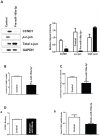Overexpression of miR-199a-5p decreases esophageal cancer cell proliferation through repression of mitogen-activated protein kinase kinase kinase-11 (MAP3K11)
- PMID: 26717044
- PMCID: PMC4891002
- DOI: 10.18632/oncotarget.6752
Overexpression of miR-199a-5p decreases esophageal cancer cell proliferation through repression of mitogen-activated protein kinase kinase kinase-11 (MAP3K11)
Abstract
Studies examining the oncogenic or tumor suppressive functions of dysregulated microRNAs (miRs) in cancer cells may also identify novel miR targets, which can themselves serve as therapeutic targets. Using array analysis, we have previously determined that miR-199a-5p was the most downregulated miR in two esophageal cancer cell lines compared to esophageal epithelial cells. MiR-199a-5p is predicted to bind mitogen-activated protein kinase kinase kinase 11 (MAP3K11) mRNA with high affinity. In this study, we observed that MAP3K11 is markedly overexpressed in esophageal cancer cell lines. Forced expression of miR-199a-5p in these cells leads to a decrease in the mRNA and protein levels of MAP3K11, due to decreased MAP3K11 mRNA stability. A direct binding interaction between miR-199a-5p and MAP3K11 mRNA is demonstrated using biotin pull-down assays and heterologous luciferase reporter constructs and confirmed by mutational analysis. Finally, forced expression of miR-199a-5p decreases proliferation of esophageal cancer cells by inducing G2/M arrest. This effect is mediated, in part, by decreased transcription of cyclin D1, due to reduced MAP3K11-mediated phosphorylation of c-Jun. These findings suggest that miR-199a-5p acts as a tumor suppressor in esophageal cancer cells and that its downregulation contributes to enhanced cellular proliferation by targeting MAP3K11.
Keywords: MAP3K11; esophageal cancer; mRNA stability; miR-199a-5p; proliferation.
Conflict of interest statement
The authors declare no conflict of interest.
Figures







Similar articles
-
Overexpression of miR-214-3p in esophageal squamous cancer cells enhances sensitivity to cisplatin by targeting survivin directly and indirectly through CUG-BP1.Oncogene. 2016 Apr 21;35(16):2087-97. doi: 10.1038/onc.2015.271. Epub 2015 Aug 3. Oncogene. 2016. PMID: 26234674 Free PMC article.
-
Circ_002033 Regulates Proliferation, Apoptosis, and Oxidative Damage of Bovine Mammary Epithelial Cells via the miR-199a-5p-MAP3K11 Axis in Heat Stress.J Agric Food Chem. 2024 Jun 26;72(25):14386-14401. doi: 10.1021/acs.jafc.3c09835. Epub 2024 Jun 13. J Agric Food Chem. 2024. PMID: 38869955
-
MiR-199a-5p Decreases Esophageal Cancer Cell Proliferation Partially through Repression of Jun-B.Cancers (Basel). 2023 Sep 30;15(19):4811. doi: 10.3390/cancers15194811. Cancers (Basel). 2023. PMID: 37835506 Free PMC article.
-
MiR-199a-3p/5p participated in TGF-β and EGF induced EMT by targeting DUSP5/MAP3K11 in pterygium.J Transl Med. 2020 Sep 1;18(1):332. doi: 10.1186/s12967-020-02499-2. J Transl Med. 2020. PMID: 32867783 Free PMC article.
-
Flexible and versatile as a chameleon-sophisticated functions of microRNA-199a.Int J Mol Sci. 2012;13(7):8449-8466. doi: 10.3390/ijms13078449. Epub 2012 Jul 9. Int J Mol Sci. 2012. PMID: 22942713 Free PMC article. Review.
Cited by
-
miRNAs Involved in Esophageal Carcinogenesis and miRNA-Related Therapeutic Perspectives in Esophageal Carcinoma.Int J Mol Sci. 2021 Mar 31;22(7):3640. doi: 10.3390/ijms22073640. Int J Mol Sci. 2021. PMID: 33807389 Free PMC article. Review.
-
Regulation of ITGA3 by the anti-tumor miR-199 family inhibits cancer cell migration and invasion in head and neck cancer.Cancer Sci. 2017 Aug;108(8):1681-1692. doi: 10.1111/cas.13298. Epub 2017 Jul 4. Cancer Sci. 2017. PMID: 28612520 Free PMC article.
-
MicroRNA-199a-5p suppresses the cell growth of colorectal cancer by targeting oncogene Caprin1.3 Biotech. 2020 Oct;10(10):453. doi: 10.1007/s13205-020-02433-9. Epub 2020 Sep 26. 3 Biotech. 2020. Retraction in: 3 Biotech. 2022 Nov;12(11):297. doi: 10.1007/s13205-022-03345-6. PMID: 33088650 Free PMC article. Retracted.
-
MiR-199a-3p decreases esophageal cancer cell proliferation by targeting p21 activated kinase 4.Oncotarget. 2018 Jun 19;9(47):28391-28407. doi: 10.18632/oncotarget.25375. eCollection 2018 Jun 19. Oncotarget. 2018. PMID: 29983868 Free PMC article.
-
A cellular regulator of the niche: telocyte.Tissue Barriers. 2023 Oct 2;11(4):2131955. doi: 10.1080/21688370.2022.2131955. Epub 2022 Oct 11. Tissue Barriers. 2023. PMID: 36218299 Free PMC article. Review.
References
-
- Ferlay J, Soerjomataram I, Dikshit R, Eser S, Mathers C, Rebelo M, Parkin DM, Forman D, Bray F. Cancer incidence and mortality worldwide: sources, methods and major patterns in GLOBOCAN 2012. Int J Cancer. 2015;136:359–386. - PubMed
-
- Siegel RL, Miller KD, Jemal A. Cancer statistics, 2015. CA Cancer J Clin. 2015;65:5. - PubMed
-
- Keene JD. RNA regulons: coordination of post-transcriptional events. Nat Rev Genet. 2007;8:533–543. - PubMed
-
- Kent OA, Mendell JT. A small piece in the cancer puzzle: microRNAs as tumor suppressors and oncogenes. Oncogene. 2006;25:6188–6196. - PubMed
Publication types
MeSH terms
Substances
Grants and funding
LinkOut - more resources
Full Text Sources
Other Literature Sources
Medical
Research Materials
Miscellaneous

